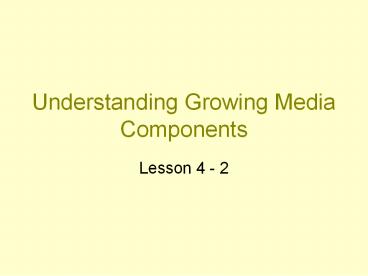Understanding Growing Media Components - PowerPoint PPT Presentation
1 / 26
Title: Understanding Growing Media Components
1
Understanding Growing Media Components
- Lesson 4 - 2
2
Next Generation Science/Common Core Standards
Addressed!
- WHST.9-12.7 Conduct short as well as more
sustained research projects to answer a question
(including a self generated question) or solve a
problem narrow or broaden the inquiry when
appropriate synthesize multiple sources on the
subject, demonstrating understanding of the
subject under investigation. (HS-LS1-3) - HSSIC. B.6 Evaluate reports based on data.
(HS-LS2-6)
3
Bell Work!
- Describe the components of soil.
- 2. List the components of a soilless mix.
- 3. Compare and contrast the use of soil versus a
soilless mix.
4
Terms
- Clay
- Inorganic
- Loam
- Mineral matter
- Organic matter
- Pasteurization
- Peat Moss
- Perlite
- Sand
- Silt
- Soil
- Soil Amendment
- Soilless Mix
- Sterilization
- Vermiculite
5
Dont Judge a Soil by Its Label!
- Never look gift soil in the label!
- What is in a soil?
- Dont count your plants before they germinate!
6
What is Soil?
- Soil outer layer of the earth that supports
life. - Recipe for Soil
- 1cu. Air
- 1cu. Water
- 1 4/5 cu. Mineral matter
- 1 tbl. organic matter
- Mix thoroughly and let stand.
7
Soil is
- 25 air
- 25 water
- 45 mineral matter
- 5 organic matter
8
Soil Composition
9
Mineral Matter
- Non-living substances generally thought of as
weathered rock. - Soil particles have 3 general sizes
- Sand largest and increases drainage (feels
gritty) - Silt medium size and gives a talc feel
- Clay smallest and higher water holding
capacity, feels slick.
10
Soil Particle Comparison
11
Organic Matter
- Organic matter is living or dead plants and
animals. - Organic matter is necessary for plant growth
because of its high nutrient content. - Higher O.M. generally increases productivity.
12
Whats in a soilless mix?
- A soilless mix is a combination of organic and
inorganic substances that provide sufficient
support for plant growth. - A soilless mix does not contain topsoil.
13
Common components in a soilless mix are
- Peat moss is plant material that originates in
bogs. Peat moss has great moisture and nutrient
holding capacity. - Perlite is white in color and comes from
heat-treated lava rock. Perlite is used in the
soil mix to aerate the soil.
14
Components Continued
- Vermiculite comes from the mineral mica and is
shiny brown in color. It has high moisture
holding capacity and is very lightweight. - Choir is fibers from coconut hulls which is
hollow and aids in water and air holding while
remaining lightweight.
15
Components Continued
- Sand large soil particles used to reduce overall
water holding capacity - Amendments are added to change the air / water
relationship of a mix while reducing the cost - Wetting Agents are soaps used to aid water uptake
of the dry mix. Also aids in rewetting.
16
The advantages of a soilless mix are
- 1. The mix is uniform. It does not vary in
components, texture, or nutrients. - 2. The mix is sterile. Sterilization is a process
that eliminates all disease organisms, in-sects,
or weed seeds. Soil mixes often contain these
items and a grower who chooses to use a soil mix
must pasteurize his or her soil before using it.
Pasteurization is the process of heating soil to
kill harmful diseases, weed seeds, and insects.
17
The advantages of a soilless mix are
- 3. Soilless mixes can be manipulated to improve
the drainage and moisture holding capacity of the
mix. - 4. A grower can personally mix the combination of
components exactly to what he or she needs for
their particular crop. - 5. Soilless mixes are easier to ship and move
because they are lightweight.
18
The disadvantages of a soilless mix are
- 1. Fertilizers often need to be added more
frequently to the mix because the mixes are
lacking in minor plant food elements. Soil
contains and holds many of these minor nutrients. - 2. When plants are grown outdoors, the wind can
blow dry pots over because the mix is very light.
19
The disadvantages of a soilless mix are
- 3. It is sometimes difficult to transplant a
plant from a soil mix to a soilless one. The
roots often will not grow into the new media and
the plant will die because it can not absorb any
moisture. - 4. There is a cost to the media
20
REVIEW
21
What are the ingredients of soil?
- Air
- Water
- O.M.
- Mineral Matter
22
What are the sizes of soil particles?
- Sand
- Silt
- Clay
23
What are the materials used for soilless mixes?
- Peat
- Perlite
- Vermiculite
- Choir
- Amendments bark, rice hulls,
- Sand
- Wetting Agents
24
What are the advantages of mixes?
- Uniform
- Sterile
- Light
- Amendable
25
What are the disadvantages of mixes?
- Light
- Need nutrients
- Cost
- Transplant issues
26
The End































